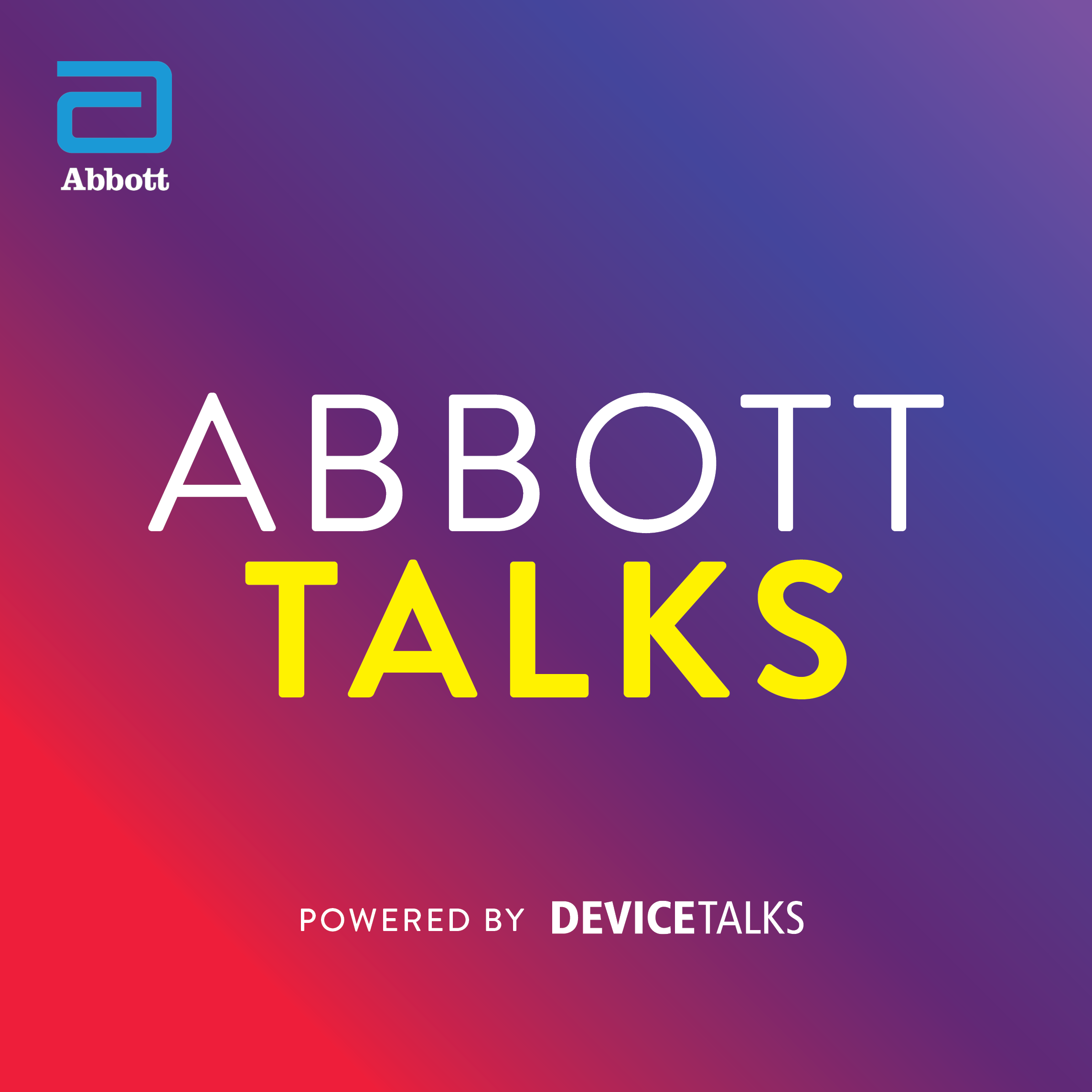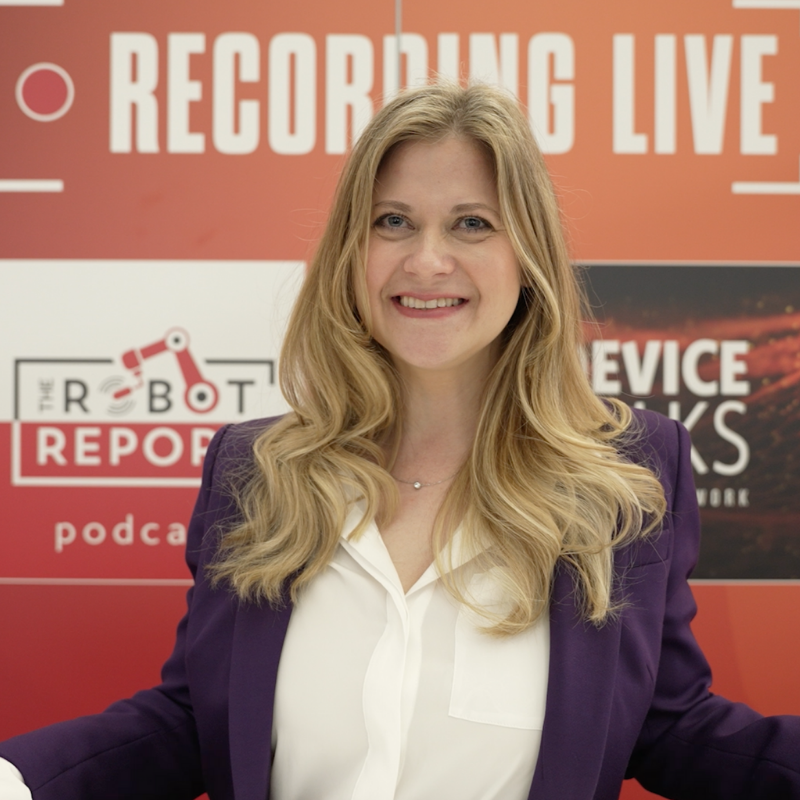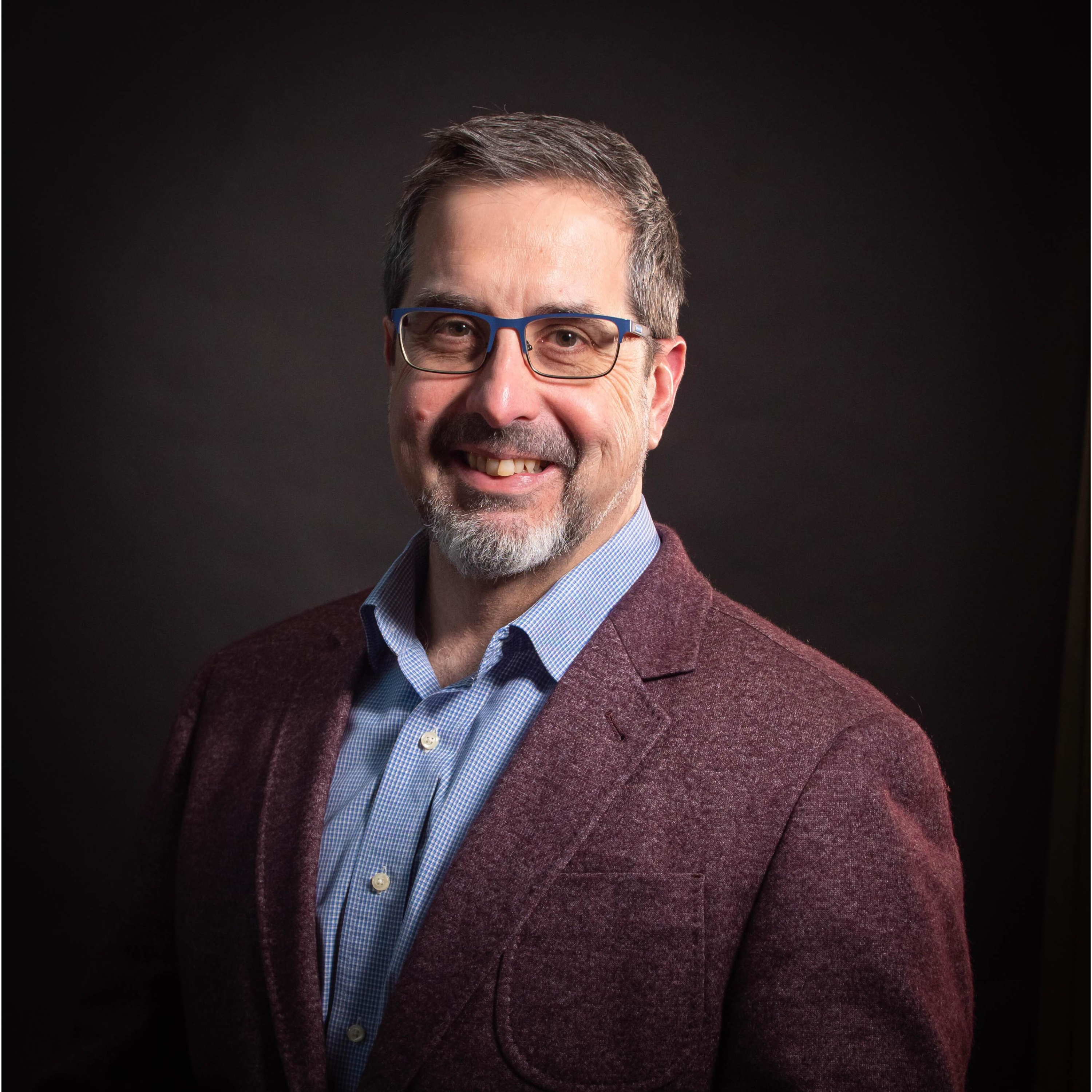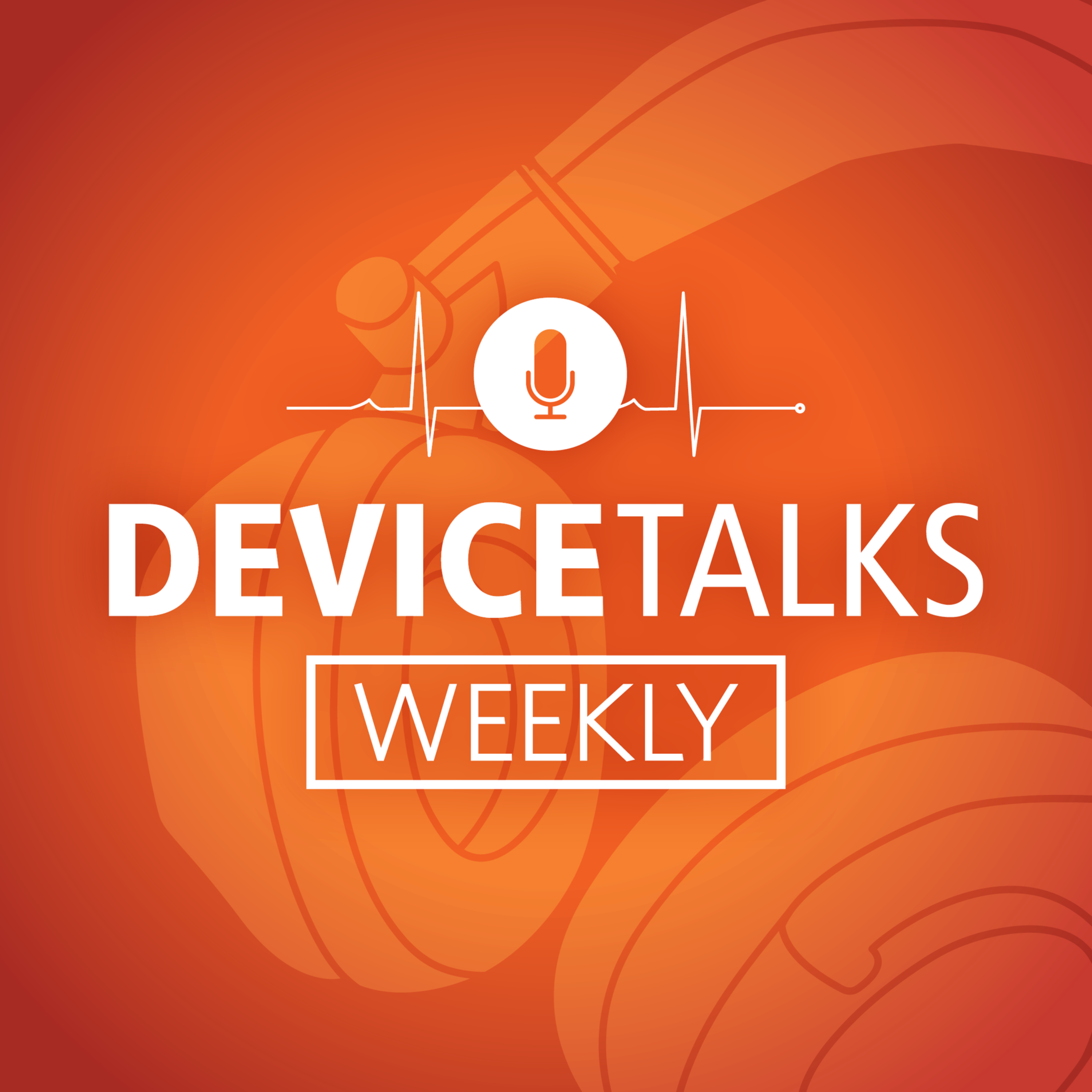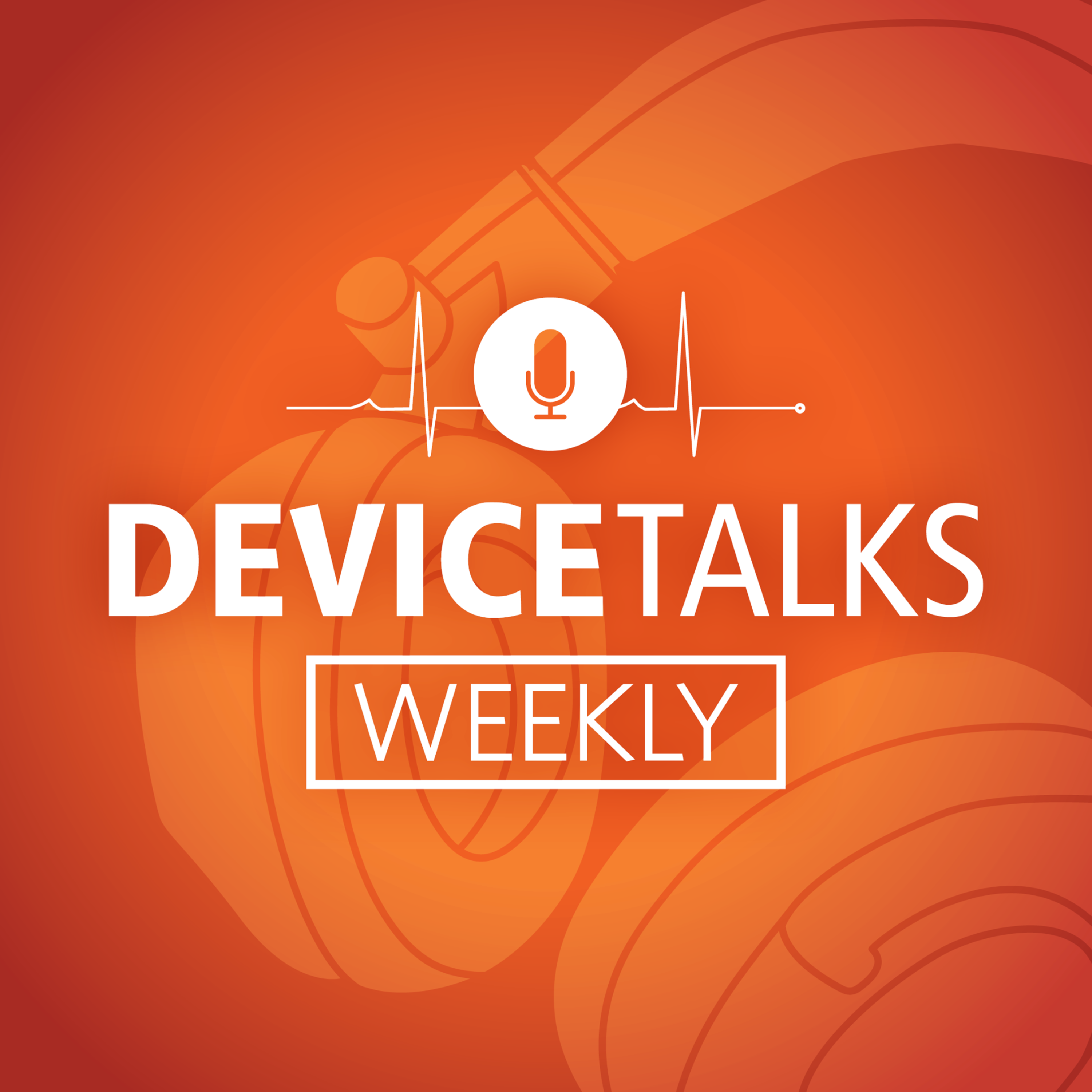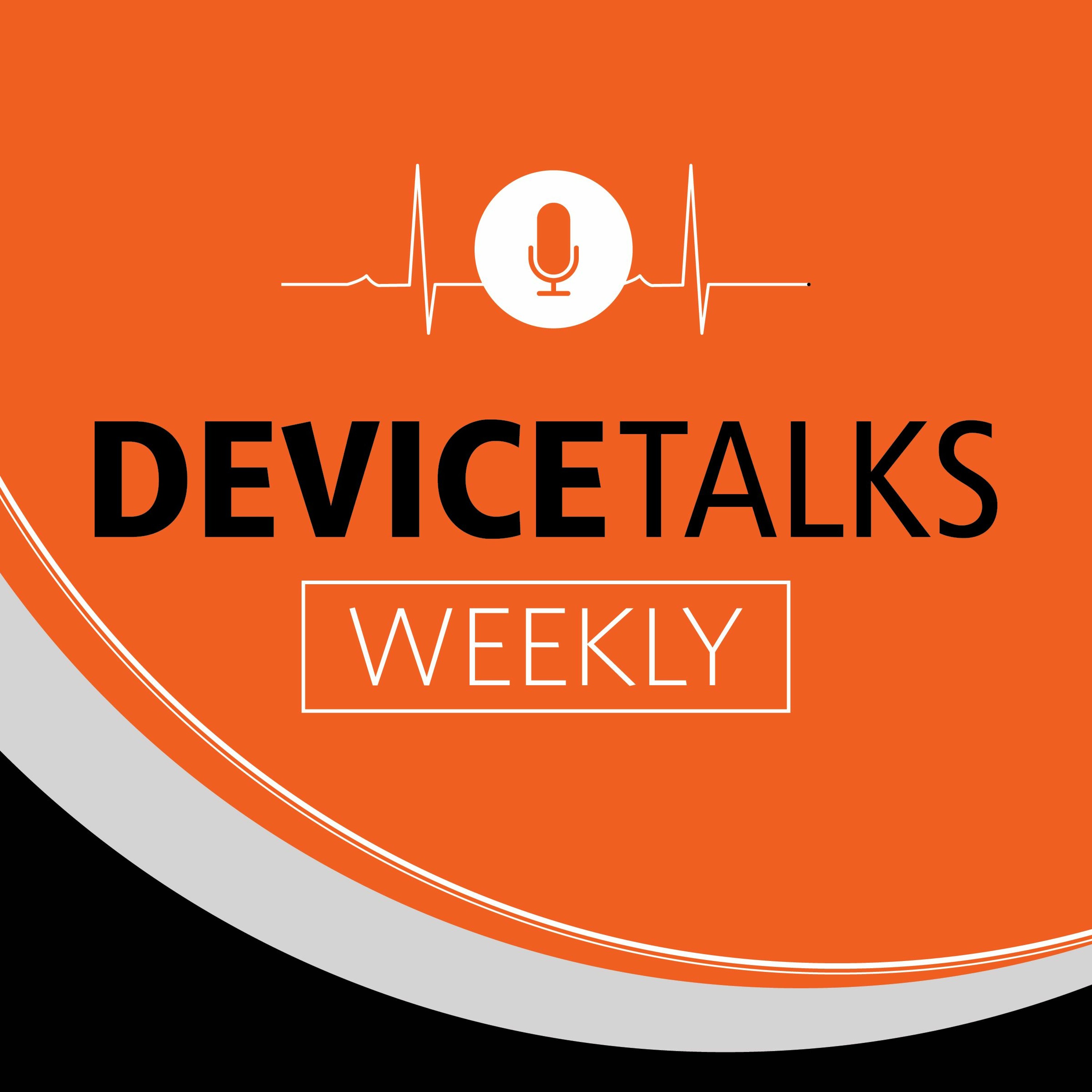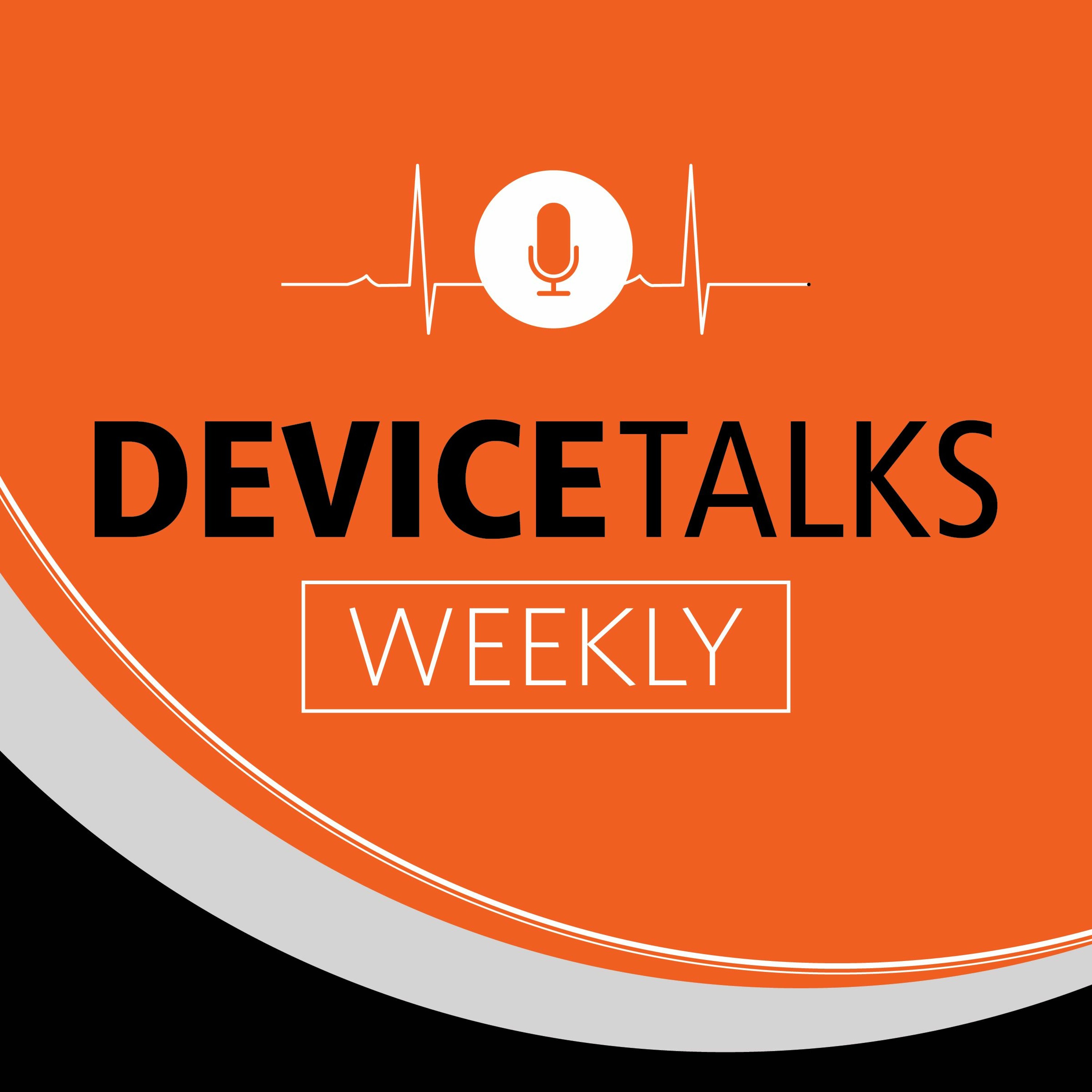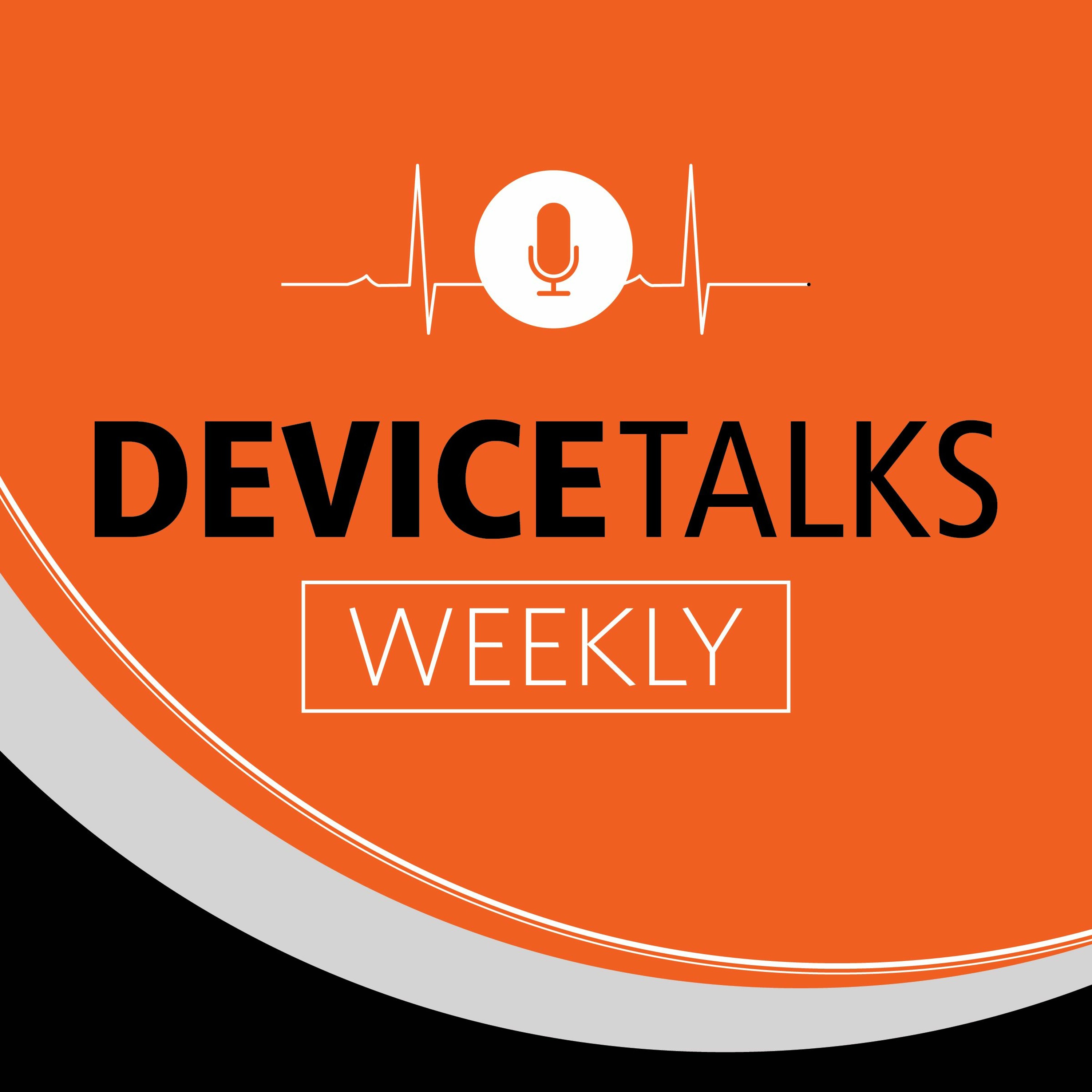Episode Transcript
Hi, everybody. This is Tom Salemi of DeviceTalks. Welcome to the AbbottTalks podcast. Over the past few years, the world has come to recognize Abbott as a company dedicated to helping people live happier and healthier lives. In this podcast series, we’ll talk with the healthcare leaders, the executives and the engineers who are working every day to develop new technologies to help people live their best lives.
I know you’ll enjoy this episode of the AbbottTalks podcast. Hey, everyone, this is Tom Salemi of DeviceTalks. Welcome back to the AbbottTalks podcast. I’m here with my fantastic colleague and managing editor of DeviceTalks, Kayleen Brown. Kayleen, we’re back on AbbottTalks. This is exciting.
Whoop, Whoop. You know, it’s my favorite time of day when I get to chat Abbott.
Get to chat Abbott. And we’re going to do a little bit of a preview for DeviceTalks West, because our guest today is. Is going to be a Speake Talks West. So we’ll get a little sneak peek on what. What he’ll be talking about on October 15th and 16th at the Santa Clara Convention Center. Kayleen, I know you’re an AI aficionado. You’re excited about learning some more about AI today.
Absolutely. I think that you can’t really have a conversation without artificial intelligence, especially when it talks about medical technology and innovating in that space and how we can improve efficiencies for better outcomes. So I am so looking forward to how Abbott is embracing artificial intelligence and can’t wait to hear from today’s guest, which has been top of my list for quite some time. So I feel like it’s a really.
Good get absolutely excited. All right, well, let’s not delay any further. I’d like to welcome Dr. Ethan Korngold. He’s the chief medical officer of Abbott’s Vascular Business. Ethan, welcome to AbbottTalks.
Thank you so much. I’m so happy to be here.
Ethan, you probably are aware we love to understand sort of the motivations, the making of the person, the why you are the way that you are. And the medical device industry is such a beautiful industry, the best industry in the world. So let’s start there. What brought you to medical devices first?
Well, I was an interventional cardiologist in practice for about 15 years, and it’s something I really loved. I loved taking care of patients and helping patients and their families. And for me, entering the medical device space was really a way of helping people on a different scale. Part of what I really enjoyed in my career as a practitioner was teaching and training and education and also working with industry, working with engineers, working with R&D and really helping to usher in the next generation of devices. And that’s something that love that I’m able to focus on in this new role.
Is it creating any confusion at the family dinner table? Folks like, are you still a doctor? I don’t understand what you’re doing there.
I, I do, I do field those questions. Yeah. Rest assured, I’m, I’m the only doctor in my family and I still get calls from all the relatives about their questions and I’m happy to take them.
I’m curious what, what I was interested in understanding the transition from, from, from being a physician into the MedTech industry. What were the questions you were weighing as you pondered sort of the move from directly treating patients and if you are still treating them, let us know. To moving into MedTech.
I’m actually so I am full time in MedTech. I think interventional cardiology. I think it’s best to focus on it full time if you’re doing it. And I was happy to make the transition full time into MedTech and into working with Abbott. I think it’s a big change and I really, I love taking care of patients, I love taking care of their families. I love the cath lab and the excitement of the cath lab and the intensity of the cath lab.
And for me the next step was really bringing those insights and bringing that voice of the physician and voice of the patient to the business world. And it’s been so yes, it was a big transition and it was definitely a bit of a leap. But I am so glad that I made that. I’m just over a year and it’s been incredibly gratifying.
So then you went from practicing clinician to Abbott. That was your first step into medical technology Industry.
Industry, yeah. And I had been working with Abbott and with some other industry partners for a number of years doing teaching training, education, doing consulting. But this is really my first sort of official full time employment with the device industry.
We’re going to be talking about the integration of AI into the vascular portfolio. So I think this is a great time for you just to. Can you give us a 3,000. Well, I was going to say 3,000 foot view, but a high altitude view of Abbott’s vascular portfolio.
Yeah, so we have a fantastic vascular portfolio. We take care of patients from head to toe, from access to closure, really the full breadth. We are not a single device company. We make multiple devices and that is really a strength of the company. And it’s A great time to be an interventional cardiologist or a vascular surgeon or an interventional radiologist, because we have so many options for how to treat our patients, how to take care of our patients.
And that introduces a whole new set of issues is how do you decide what the best choice is for treating a particular patient with a particular problem? And that’s where I think AI can really help. We were one of the first to bring AI into the cath lab with our Ultreon 2 technology that is really helping physicians to make the best decisions for how to take care of their patients. And we see that as just the beginning for bringing AI into the Cath lab, helping to navigate physicians through difficult decisions so that they can get consistently the best results for their patients. So that’s where I think the future of AI is in the Cath lab, in the vascular space. It’s to help as a decision making tool for physicians to get consistent, reliable results.
I definitely want to dig in more on artificial intelligence, but maybe just for our audience, Ethan, can we just zoom back a little bit and can you give us just an overview of the Abbott’s vascular portfolio in general so that we can start narrowing down and it just sort of helps us understand the lay of the land.
Yeah, of course. So in the coronary space, so we have our XIENCE drug eluting stent platform, which is really has superb outcomes. One of the best study medical devices of all time, our full range of wires and balloons. We have an intravascular lithotripsy device, which is in clinical trial, which we’re very excited about. Intravascular imaging with our OCT platform, which is now Ultreon 2.0, which as I mentioned, was really the first instance of bringing AI into the Cath lab.
That’s the majority. Then orbital atherectomy for challenging lesions with severe calcium. That is our way of prepping the vessel in order to get optimal results in the vascular space, starting from head to toe. So carotid stents. That’s an area that we’ve been involved in for decades with a huge body of evidence supporting the use for appropriate patients. And then down to lower leg, or, sorry, peripheral arterial disease and lower extremity disease from things like the interwoven supera stent, which is really an excellent device for very challenging lesions, including calcified lesions, which is highly fracture resistant.
And then below the knee intervention. We’ve really pioneered the space with the bioresorbable Esprit BTK scaffold, which is a way of opening up vessels below the knee with a resorbable scaffold so that it heals, the vessel, delivers drugs and then disappears within about three years to leave a healthy vessel behind. We really feel like we are experts when it comes to all of the vascular spaces in the body.
So coronary disease, vascular disease, and our knowledge, our skills, our expertise really sort of crosses over from one field to the next.
You weren’t exaggerating in any way when you said head to toe.
Absolutely, yes.
I’m going to cut in here really quickly to bring you my conversation with this episode’s sponsor, Eric Veit, VP of Business Development for Nitinol at Resonetics. Eric Veit, VP of Business Development for Nitinol at Resonetics, welcome to the podcast.
Thank you, Kayleen. I appreciate you being here. Thanks for having us.
So I’ve had the pleasure of sitting down with several members of Resonetics, but if you don’t mind, Eric, can you remind us how Resonetics supports medical device companies and how you work with nitinol and components?
Sure. So Resonetics is really known as experts in the micro manufacturing area. We support, you know, interventional advanced surgery, advanced diagnostics and bioelectronics. And nitinol fits into that in a lot of areas, mostly in the interventional and advanced surgery side and toward looking toward the future a little bit on the advanced diagnostics and bioelectronics side of things.
Great. Can you take us through a focus on how Resonetics works with Nitinol?
Sure. So we provide, we’re a full service provider in Nitinol. We’re totally integrated. We make our own melt and we take that all the way through. We call it melt to market. So we from the melt side all the way to the market, as in the market being advanced components, both delivery components and implantable components like heart valves or electrophysiology components.
So that was a really good overview. Can you help us understand maybe how you work directly with medical device companies?
Sure. We work with everybody from startups through multinational, you know, large corporations. And we work in the initially with the R&D departments and prototyping. We have what we call Lightspeed Lab, which is our rapid prototyping group. They turn quotes around in a day, turn parts around in a week to two weeks. And that really gives us a leg up to work with these R&D departments, prototype parts and get those moving toward production.
Goal eventually is to produce those parts in a high volume environment. And so we are set up to do that by making our own equipment and we have a whole team that works on transferring projects into production.
I’m going to pause our conversation with this episode’s sponsor, Resonetics, to bring you our keynote interview with Dr. Ethan Korngold, Chief Medical Officer for Abbott’s Vascular Business. But if you can’t wait for the second part of that conversation, please visit Resonetics.com that’s www.r e s o n e t i c s.com. And now, Dr. Ethan Korngold.
I always saw vascular as kind of the portfolio, as more of a mechanical sort of product where you’re directing blood or redirecting blood, or you’re just more physically involved in the body’s function. And I see AI as more of a collector of data and sort of more of a knowledge base thing and something that will allow doctors to interact with the device more. So I don’t naturally see AI as a natural, as a natural fit for the vascular portfolio.
What am I missing? Where does. You talked a bit about the fit earlier on with oct, but more broadly, where does AI fit into a vascular portfolio?
Yeah. So I think it really comes down to the decision making. So for example, an interventional cardiologist who’s seeing a patient in the cath lab will have to deal with should this lesion be treated? Is this a blockage? That’s something that’s significant or not, that’s causing the patient’s symptoms and will the patient benefit from from an intervention? So that’s the first decision point. Then it would be how should that vessel be treated?
Does that vessel have calcium in it to the extent that it needs special vessel prep with something like atherectomy or intravascular lithotripsy? Or is it something where a balloon alone would suffice in opening the vessel? Then we’re entering this new world where we have drug eluting stents which have an excellent body of data. There is drug coded balloons which are emerging and perhaps other technologies including bioresorbable stents in the coronaries.
What would be the best approach between those three for definitive treatment? Then finally, when it’s done, how did you do? Is the vessel successfully treated? Is there something that needs to be go back, that needs to be readdressed, or is the procedure done and then how should that patient be followed up? So there are these branch points at every step of the procedure and that’s where we feel that AI can help to guide a physician in making the best evidence based, informed decisions that are tailored to that specific patient, that specific patient’s anatomy and really bring the body of evidence to help the physician make the best decisions, even under difficult circumstances.
That brings up so many additional questions. So it makes a lot of sense. Like in some way this is streamlining the decision making process. The personalization approach, I think, is key here. So maybe the first question that kind of comes out of that is, how are you personalizing the Tom’s point? Artificial intelligence or data in, data out? How are you accomplishing that goal?
Yeah, so let’s start with where we are now with Ultreon 2.0. We’re using artificial intelligence to help identify the diameter of a vessel. That’s something that previously would have to be done manually. So a physician would have to pull up the OCT image to determine what the sort of layers of the vessel are, and then manually draw lines across to assess the diameter. That’s something that by training an AI, we can do that with very high accuracy and get images in a split second.
We can make that measurement and sort of relieve that burden from physicians in order to get a more accurate result. We can also identify calcium, so we can flag areas of significant calcium along the vessel that might be needed to be prepped with additional therapies, such as atherectomy or intravascular lithotripsy. And again, that’s something that is just overlaid automatically on the OCT images as they’re taken.
We know from studies published earlier this year that that the AI assistance in interpreting the OCT is more accurate and is faster than a manual assessment. So that’s sort of the first step. The next step will be adding even more AI interpretation into the image interpretation. So it’ll do things like it’ll look at lipids and it’ll automatically detect lipids, and it will calculate what we’re calling vfr. So this is a hemodynamic assessment of the vessel, and it will use that to help intelligently suggest where a stent should land. So that a stent lands, avoiding areas of plaque, avoiding areas of lipid, and in order to get the maximum hemodynamic gradient relief.
So these type of things, you know, we see this as a stepwise progression. We really see that Ultreon and AI is the future of navigating PCI in the Cath lab. Just like GPS helps you to navigate from point A to point B. And just like gps, like Google or Apple, it has sort of different modules that come out on a regular basis. That’s sort of how we see the evolution of this technology to be that in a stepwise approach, we can add Functionality, we can add features and we can help the decision making process be smoother, more reliable, more evidence based, so that we can get consistently better outcomes for our patients at all levels of skills of operators.
Can you give a little illustration when you say faster, how much faster and what does that mean for the care of the patient? Are they, are they currently or were they previously going home and now they come back? Are they able now to stay in the clinic? How is this sort of presenting itself and improving the patient experience?
Yeah, so that’s a great call. So when a physician does intravascular imaging, if they get an OCT image, we have this huge amount of data. The strength of OCT is really that it gives extremely high resolution images of the vessel. And because of that, we can train our AI with a high degree of accuracy in order to make these measurements and these assessments. Really every moment, every minute in the cath lab is something that we’d like to minimize. We want these procedures to be as quick and efficient and streamlined as possible to get patients through the procedure safely and ultimately home and recovering safely.
And so for us, anytime we can sort of trim time out of the cath lab and do it with increased accuracy, that’s really a win for patients. We know from a huge body of evidence that using intravascular imaging leads to better patient outcomes. And that’s why this past year intravascular imaging with OCT or with IBIS has been given a Class 1A recommendation. That’s the highest recommendation by American and European bodies.
I’m going to cut in here really quickly to bring you the conclusion of my conversation with this episode’s sponsor, Eric Veit, VP of Business Development for Nitinol at Resonetics. So I understand how Resonetics is working with nitinol, but how is Resonetics different compared to other component suppliers?
I think what’s different is that we’re really working to be a world class partner. We want to partner with companies to be able to provide raw material component processing, high volume manufacturing, soup to nuts. We do it, we cover it, we want to work with them. And we do that through a backbone of science. So we have a backbone which we call our advanced technology group and they’re technical experts down to the material science level, you know, down to the microstructure of the, of the nitinol and how that’s impacted by processing it, what, how to optimize it, how to get the best out of your performance of your, of your parts.
And that’s what we offer and that’s what we enjoy doing every day.
Perfect. Let’s look to the future. So how do you see Nitinol being used in the future in terms of component applications?
Yeah, that’s a great question. I actually wrote a post recently called Nitinol through the decades on LinkedIn and gives you kind of decade by decade breakdown of some of the parts that were are made and looking the future. It, you know, there’s right now you can’t really 3D print Nitinol. There’s experimentation that you can 3D print it. But I think for the future those things will get worked out and for orthopedic applications, you know, you’ll be able to use it.
There’s passive and active microelectronic implantables. You know you have heart failure is definitely an area that’s up and coming and the use of devices there. Then if you combine sensors with batteries like the synchron neurological implants that will have sensors and batteries implanted, be able to both monitor brain function and also change it. I think those are applications of the future then from an AI perspective actually in the process, not the component side, but that would be things like using artificial intelligence to data.
For example, on heat treatment we’ve already started doing this where we’re incorporating our knowledge of heat treatment and creating AI models where the number of steps, the, the outputs that you want, the AF temperature, that final, that the number of the heat treatment temperatures, all that’s put into the model and it’s kind of creating a smart engineer for, for anybody. You know, it’s, it makes the average engineer into a, a technical fellow. You know, of course it’s just like ChatGPT, you got to check it. But it gets you, you know, get you halfway there.
That’s a lot to look forward to in the future. And I think I’m going to have to 100% put that LinkedIn post link here in the show notes because I’m sure my audience would be very interested to learn about night and all through the decades. So for our audience, please take a look right there. Eric, VP of Business Development for Nitinol at Resonetics. Thank you so much for joining us on the podcast, giving me a little update on Nitinol and what we can expect from it to come. So thank you, thank you again.
Thank you, Kayleen. I appreciate the time.
Huge thanks to Resonetics for sponsoring this episode of AbbottTalks. We really can’t tell these important stories without your support. So thank you, thank you, thank you. And to our audience, to learn how you can work with Resonetics and learn more about Nitinol, please visit their website www.Resonetics.com. R e s o n e t i c s.com. Thanks again. And now, Dr. Ethan Korngold.
How do your colleagues, or former colleagues, how accepting are they of this guidance from AI? Is there an embracing of this is going to help us immediately? Is there a sense, as we’ve seen with other technologies, I can do this, I’ve been doing this. I don’t need the help. How is this being received from the clinicians?
Yeah, I think so. In our current implementations, physicians love it. So having the AI automatically assess a diameter, which is something that would have to be done manually, that is a huge plus. But I think it’s something that we have to be very sensitive about going forward. And that’s, again, I think a big strength of Abbott is that we have this history of partnering with physicians. We know what proceduralists are looking to during the procedure, and we have to be sensitive about this.
We know that there is no substitute for a physician’s experience and intuition about a procedure and about a patient. There is no substitute for a physician’s relationship with the patient. And we are not looking to replace that. We are looking to augment that and provide additional tools and additional guidance for a physician who’s undergoing a potentially very challenging procedure.
I’m sure if you’re showing time saved, that’s an easy selling point.
I have to wonder about the hospital system point of view. From your experience, how are hospital systems either embracing or not embracing AI?
Well, I think that one of the potential advantages of AI is that it would lead to improved outcomes for patients. And I think quality is something that hospital systems care about very deeply. And I think that when we are designing systems for AI, we’re really looking at systems that will elevate the quality of procedures and the outcomes for procedures for all settings, whether it’s a rural hospital, whether it’s a tertiary care center, and all levels of experience.
So we want to design AI systems and decision support systems that really make every physician perform better and get better results for their patients. And I think that’s something that hospital systems will find appealing.
If I could borrow your brain for a moment. It’s always a privilege to be able to speak to a practicing clinician who has transitioned into industry. And I tried to describe my job to my mother, and we haven’t made. After 19 years, I still haven’t made a lot of progress in describing exactly what I do, exactly what you do, and if you could indulge us, could you take us through what that pathway might look like for a patient?
So why would a patient need intervention? What would that look like with the, you know, artificial intelligence? Like, can you just take us through, like the beginning to the end, as if we were speaking to my wonderful mother?
Of course, sure. So there are sort of. So let’s talk about coronary interventions just to sort of limit the discussion a little bit. And there are in general sort of two reasons for people to get coronary interventions. One of them is for an acute coronary syndrome, say a heart attack. So if a person were to have chest pain, out of the blue, sort of crushing chest pain person would come to the emergency room and be evaluated emergently.
And that’s typically caused by a blockage in one of the coronary arteries that supplies blood to the heart. So we know from a huge body of data over decades that the best treatment for that is to open up the coronary artery as quickly as possible. And so that patient would be taken emergently to the cardiac catheter lab. An angiogram would be done to identify the blockage, and then that would be opened up by passing a wire through the blockage, opening up with a balloon and then a stent, which is a wire cage to prop open the vessel.
Modern stents are coated with medication, so called drug eluting stents, to help prevent re narrowing within the vessel. And a patient like that who would have had a heart attack, typically these patients are watched in the hospital for a couple of days and then able to go home. So it’s incredibly dramatic, life changing technology to be able to take someone who is gravely ill with a heart attack, instantly resolve their pain by opening up the vessel and sending them home.
Now we know that in settings like this, that using intravascular imaging in order to look at the inside of the vessel with light in the case of OCT, or with ultrasound in the case of IVUs, can help place a stent and open up the vessel with even more accuracy than using just a simple X ray image. But the process of obtaining that imaging can be a challenge for some physicians. And that’s where I think AI can help streamline the process of obtaining those images, interpreting those images and acting on those images.
And that’s where we are now. But beyond that, there are multiple steps at every point in the process where I think AI can really help. And what we’re looking for for patients is to get better outcomes, to have quicker, quicker sort of results, quicker resolution of symptoms, and a More sort of streamlined patient flow through the hospital. So that’s where I really see AI is at this point we’re looking at the intravascular imaging space. But the future, the future of AI in the cath lab is to help with more decision support at every stage in the cath lab and then extending to before the cath lab and after the cath lab. So you’re helping physicians plan their procedures on the front end and on the back end you’re helping assist with what is the best follow up for the patient, what is the best medical therapy for the patient, what needs to be done in the future.
What does that timeline look like in your head? I mean, we’ve seen the adoption of AI and a number of conversations. Kayleen and I have that number of questions we asked that center around AI probably 3 or 4x than they were even 2 or 3 years ago. What are we looking at the next 5 or 10 years? Do you see the cath lab changing significantly because of the introduction of AI or. I’m sure we’ll recognize it, but how different experience might it be?
I think that we’re going to see a stepwise inclusion of different modules that help with different decision making at different points. And I think that, you know, we’re seeing that sort of internally with Ultreon 2.0 and Ultreon 3.0. I think as we go forward, we’ll have sort of more and more modules and eventually, you know, we know what the goal is. But I think that on the way to the goal, we will hit a tipping point where this becomes really an essential tool.
I don’t know about you, but even if I’m driving home, I still turn on my Google Maps just to help navigate me, just to know, is there an obstacle in the way? Is there traffic? And I think exactly. And so I think we will get to that point. So even if you’re doing a routine procedure, you will want to have the assistance of an extra set of eyes that’s helping you out. An extra just sort of check on what you’re doing to make sure that you’re making the best decisions in the best way possible for your patients.
Such a good analogy. I find myself plugging in my gps, going a single highway on the way home. I’m like, what am I doing? Like, I’ve done this 10,000 times, but I feel blind without it. I mean, does that carry over into the interventional suite or into practicing medicine?
I imagine it would, yeah, absolutely. I mean, we talk a lot internally about how we see the future of AI in the Cath lab as the sort of GPS for the Cath lab. And we’re using that navigation analogy to really help guide the decisions that we make and what we’re investing in as far as AI and Cath lab. That’s what we see. And just like how with gps we know that a well trained London cabbie can beat Google Maps when it comes to certain things.
So there’s no substitute for experience. But what we see this is, we see this as arming physicians with another tool. So think of this as like a London cabbie with a gps. So you get the best of both worlds and you can really again help physicians at all levels of experience experience to make quicker, more accurate, more reliable decisions that will help their patients and produce better outcomes.
Feels like a win, win, win situation. And again, I really love the analogy because that feels more approachable. And there tends to be sometimes this fear factor when it comes to AI. I know that I face that myself. Sometimes I wake up at 4 o’ clock in the morning, go, oh, it’s the beginning of the end. And then I talk myself back down and think about really - and how Tom hears me say this all the time - that artificial intelligence is going to allow humans to be more human, which kind of touches the London cabbie. Now he or she can spend more time showing the sights and giving the inside details, knowing that the GPS is going to be a support in those kinds of functional decision making.
If we were to look at Abbott’s vascular portfolio kind of at a higher level, like where do you see, because we’re talking very specifically right now, but where do you see AI having its biggest impact, like in the portfolio in general, like is it diagnostics, is it intervention, patient monitoring?
I think that in terms of the, I think looking at the procedure is going to be the biggest impact sort of most early on, but I think that we’re going to see that expand on the front end. So we talked about the example of someone with a heart attack, but there’s a significant portion of interventions are done in patients that have stable symptoms. What we’re seeing in the future is that more and more patients will be having CAT scans in order to assess their vessels.
What we like to do is we’d like to be sort of interfaced with that into more of the pre procedure planning so that we’re helping physicians sort of figure out what they’re going to be dealing with in the procedure, model how their procedure should be done so that they can go into the procedure with a sort of plan in place for how things are going to go. That again, we think will ultimately lead to better outcomes, lead to more consistent results, more efficient procedures.
And then on the back end, we see AI as helping to guide physicians with their medical therapy for patients for their follow up plans. So, for example, guiding how long patients should be on antiplatelet therapy, what kind of statin program a patient should be on. So we see it sort of extending to before and after the cath lab. So for the planning phase before and for the follow up phase after, fantastic.
It’s less about a specific area, more about the entire cycle and getting all those key touch points. It’s very exciting. I have a lot of hope. So thank you for sharing that.
It’s a very, very exciting and dynamic time and we have so many options in the field. And so to be able to create something to help physicians choose amongst them, I think that is really the next phase in the evolution of intervention. Great.
Hopefully you can share this podcast episode with your family so they know exactly what you do for where we’re living now that you’re not a doctor full time anymore. But Ethan, thanks for joining us on abbotalks. And for those listening to this fresh off the press, make sure you join us at DeviceTalks West. They can meet you in person there and watch your presentation, an even greater presentation on this very same subject. So thank you, Ethan, for joining us.
Fantastic. Thank you.
All right, that was a fantastic conversation with Dr. Ethan Korngold. He’s the Chief Medical Officer of Abbott’s Vascular Business. And I love doing these Abbott talks. I think Abbott just brings some really, really great guests. And what a great addition to the MedTech industry.
I can’t even agree more with that. And then Dr. Ethan Korngold has been with Abbott now just a little bit more than a year. So just knowing the power of practical medicine on top of innovation in the industry, I mean, it’s an unstoppable combination. And I’m so grateful to have been able to learn from Dr. Korngold. So thank you, Abbott, as always, for the opportunity.
And of course, we couldn’t do this without our great sponsor, Resonetics. Resonetics is a steady supporter of DeviceTalks, of our podcast, of our events, of our webinars. We’re really grateful to have them as a partner. And Kayleen, if someone wants to work with Resonetics, where should they go?
The first step should always be Resonetics.com that’s R E S O N E T I C S.com. Thank you, thank you. Thank you to Resonetics for allowing us the opportunity to tell these really important MedTech stories. We can’t do it without you.
Absolutely.
And make sure you connect with Resonetics on LinkedIn, connect with myself, connect with Kayleen as well. Follow DeviceTalks and of course, subscribe to the DeviceTalks podcast network so you don’t miss a future episode of AbbottTalks or are there great, great podcasts. So, Kayleen, it’s a pleasure to do these podcasts with you. Well done today.
I loved every second of it. Thanks so much, Tom. And thank you again to our DeviceTalkers, to Abbott, and to Dr. Ethan Korngold, and of course, Resonetics. Thank you.
Thanks everyone.
